#el Canigó
Explore tagged Tumblr posts
Text

L'eix Rènnas del Castèlh - Girona, que té en els seus extrems les dues torres Magdala existents en ambdues localitats, si bé la de Girona, la primera en esser bastida, ja fa anys que fou enderrocada.

Al seu llarg aquest eix travessa algunes contrades i punts de gran interès tant esotèric com llegendari.
#mapa#cartografia#cartografia esotèrica#Torre Magdala#Girona#Rènnas del Castèlh#Catalunya#Occitània#Bugaraig#el Mont#Besalú#el Canigó#Canigó#Puig de Bassegoda
1 note
·
View note
Text
30 llibres en català!
Bon any! (Sí, ja sé que arribo molt tard, però necessitava un descans després dels examens i tant de viatjar durant les vacances 😅) Porto un temps volent fer algun pas més amb el català, com que ja tinc un C1 còmode i no gaire pressió per millorar. El fet és que arribat en aquest punt, encara em queda moltíssim per aprendre, i per fer el pas al C2 i més enllà he d’esforçar-me més per afinar el lèxic i aprecisar els registres. També és cert que no he tingut gaires oportunitats aquest any per utilitzar el català, i es nota. Però tot això té un remei: tornar a estudiar, verament estudiar, el català.
Amb el C1 i C2, com que depenen tant de l’ús precís i mesurat de la llengua, és molt important interactuar amb una diversitat de gèneres i estils lingüístics. Amb el català, no tinc cap problema amb la gran majoria de registres orals ni escrits, si és que són informals, però entrats en coses més formals ja hi tinc molt menys familiaritat. També cal dir que el llenguatge literari sol ser més ric, tant a nivell lèxic com estilístic, i per això és un bon punt de partida per treballar la llengua. A més a més, llegir en anglès ja forma una gran part del meu dia-a-dia, i tot i que no puc canviar-ho tot al català, fer que el català sigui una de les llengües que faig servir tindrà un impacte important en el meu nivell i també podrà ser una part fonamental de la meva vida professional en algun moment, com que em vull dedicar a la catalanística. Per totes aquestes raons, crec que posar-me a prova amb la lectura en català serà un bon repte.
He pres com a punt de partida aquest repte en castellà (que he arribat a conèixer gràcies a, i que també ha estat elaborat més per @cernuda), però he decidit rebaixar la quantitat de llibres per algunes raons: (1) la persona que ha fet el repte ha triat llibres més curtets, i jo en tinc algunes de 500 pàgines i més, per tant crec que és més que justificat, (2) tinc moltes coses que em demanen l’atenció i sé que si poso un número més alt no em trobaré amb els ànims d’acabar el repte, (3) vull tenir el temps d’assaborir alguns d’aquests llibres perquè són clàssics, i (4) ja faig moltes més coses en català, i llegir 30 llibres ja per mi són molts llibres per llegir en un any, ni que siguin en català. Crec que, vist així, té tot el sentit del món la xifra que he triat.
Tinc una llista més o menys elaborada, amb una gran varietat de llibres (no-ficció, juvenil, medieval, poesia, tant moderns com clàssics de la llengua), i espero que amb això ja tindré prou per ocupar-me fins a desembre. Si teniu recomanacions ja em direu, i moltes gràcies a @no-passaran i @quimerathetraveler per l’allau de llibres que ja m’heu recomanat, sou els millors ❤️ Si algú més s’anima a acompanyar-me, ja em diràs i podem intercanviar llistes. I amb això, apa, a llegir!
#catalan:general#catalan:goals#general:goals#no prometo absolutament res de contingut perquè amb llegir ja n'hi ha prou però si ha un llibre que m'agrada en especial us ho diré#però vull llegir tirant lo blanc el canigó el llibre de meravelles i incerta glòria com a mínim#fa temps que els he volgut llegir però necessito una excusa per fer-ho#em sap greu quimera no m'ha deixat etiquetar-te 😔✊ però mil gràcies per totes les recomanacions ja confio que veuràs aquest post#ostres porto el català formal fatal però ja ho treballarem ja :///
24 notes
·
View notes
Note
Moltes gràcies!
I guess this message would make more sense in Halloween, but I don't want to wait that long lol. Are there any well known ~haunted places~ in the Catalan Countries?
Yes! There are many legends about haunted places. Most of them can be divided in two groups: ànimes en pena (spirits) and encantades (Moorish ladies under a spell who guard a treasure cave).
1. Ànimes en pena
"Ànima en pena" literally means "soul in sorrow", but it's similar to a ghost. It's the spirit of a person who can't go to the Other Side because they are damned, weren't buried properly or as a result of how they died. This person will look the way they looked on earth (no white blankets here) and sometimes with an added punishments (be on flames, be chased by dogs, can't dismount their horse, riding the skeleton of a horse, etc). Some of them only appear under certain circumstances, like at night. The particular details depend on each legend: depending on the circumstances and how grave their punishment was, they can be a simple spirit or more similar to the Wild Hunt motif.
There are places that are said to be haunted by an ànima en pena. Many of them are just a dead person who asks the living to say a message on their behalf or finish something they left unfinished, and then they can go in peace. But others are damned for eternity. I will explain the most famous one in Catalonia.
The most famous one is Count Arnau (Comte Arnau), also called Count Evil (Comte Mal) in Mallorca. I made a post about him a long time ago, but it's always a good moment to bring him back. Count Arnau (might be the real Arnau de Mataplana) was Medieval noble who committed various sins. Some say he was forced to marry a 7-year-old when he was 15, but he was actually into another woman who was a nun in the monastery of Sant Joan de les Abadesses. Catholic nuns make a vow of chastity, but n'Arnau ignored the holy laws, seduced her and had sex with her. Some versions say that the nun died shortly after joining the monastery, and on a stormy night n'Arnau stole her corpse from the grave and rode away carrying her on his horse, but in his madness he couldn't see where he was going and fell down a cliff. It's also said he did not keep his promises to his feudal subjects and did not pay his servants what he owed them.
For his sins, he was punished to roam eternally as an ànima en pena, riding a black horse on fire and chased by diabolical dogs. Since at least the 16th century, people from the area have been saying they see him on stormy nights.
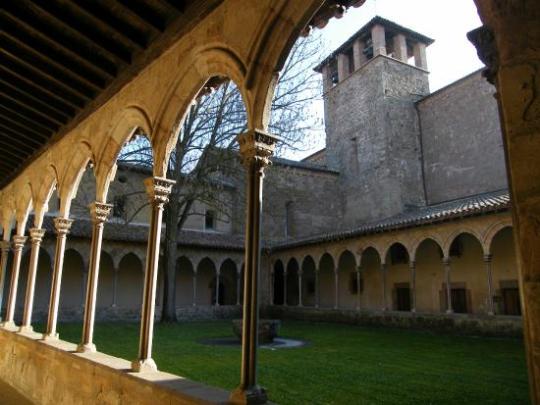
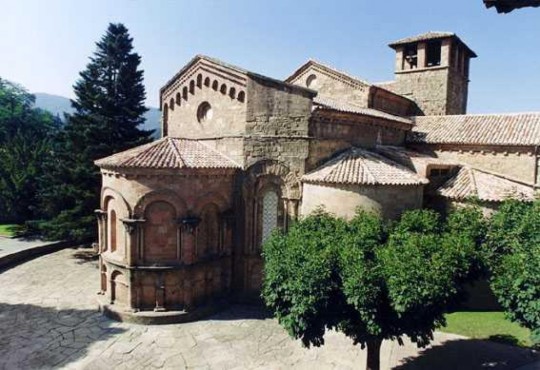
Sant Joan de les Abadesses monastery, Comarques Gironines, Catalonia. x x.
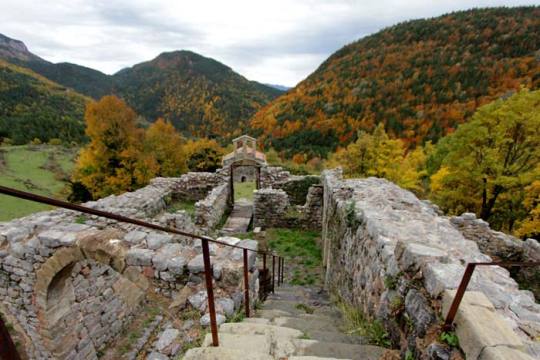
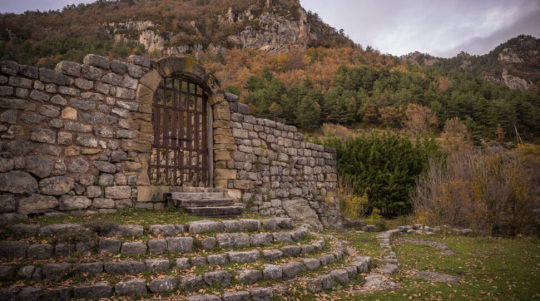
The ruins of Mataplana castle: Count Arnau's castle. Comarques Gironines, Catalonia. x x.
In many other places of Catalonia they have similar legends of the Wild Hunt. Many of them have to do with a nobleman or a hunter who ignored God to go hunt a specially big hare and is now damned to hunt eternally. Or, like in Gréixer, he killed the priest and ran away to the forest, so now he's eternally running in that forest and can't ever stop.

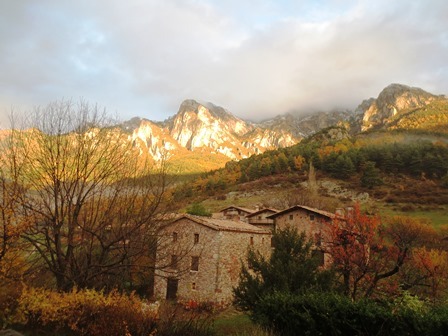
Gréixer, in Guardiola de Berguedà. Where the hunter hid and is now forever running. One example of the many damned hunters. x x.
2. Encantades
The second kind of haunted places are those hunted by an encantada ("enchanted woman"). This is not to be confused with dones d'aigua ("water women"), a being of Catalan mythology who are also called encantades in some areas of the Northern half of Catalonia, which is related but different.
Here I'm talking about the immortal spirits of Moorish women who guard treasures. This kind of legend is very common in the Valencian Country, the south of Catalonia and the Balearic Islands (the areas that were ruled by the Islamic kingdoms for a longer time).
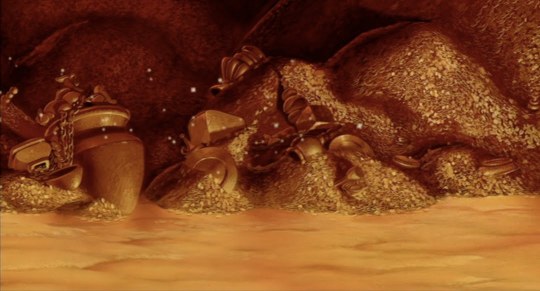
Still from the Disney movie Aladdin.
The legend is always the same: in the Middle Ages, when the Christians conquered this land, the Moors had to run away but they always had the hope that they would come back home. For this reason, they left their riches and treasures hidden (usually in a cave), which is guarded by an enchanted woman, who is immortal until the spell is lifted. Many have tried to find these treasures, but beware: there is always a trick.
This post would never end if I listed every town, cave or small lake that has a legend like this. There are many, and each will have some difference to how the woman was enchanted or what will happen if you steal from it. I will tell three as an example.
This is the legend told of the encantada of Planes: every 100 years, an enchanted Moorish woman leaves her hiding place in the little lake (called Barranc de l'Encantada, "the Enchanted Woman's little lake"), wearing a diadem of pure gold. She will talk to the first farmer she sees working in the nearby fields and ask him "which one do you want to keep: the gold diadem or me?". If the farmer answers the diadem, it means he's greedy so she will kill him. If he chooses her, she will take him to the cave, where he will remain under a spell forever.
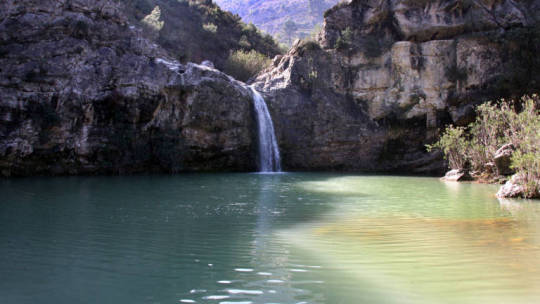
El Barranc de l'Encantada in Les Planes, Central Valencian Country. x.
In the Benidoleig cave, the legend says that two Moorish men who had stayed after the Conquest had an old book that said how to retreive the treasure. They proposed to two Christian men to go get it together, following the books instructions: they would need to go at night, when they reached the cave they would read out a magic spell, burn some herbs, and when they reached the treasure chamber throw a cat without any black hair on it.
And so they did it: at night, they entered the cave. They found an enchanted Moorish woman who asked the Moorish men "why are you bringing enemies to the treasure?" but they ignored her and continued walking in. They followed the first part of the ritual and reached a treasure chamber with mountains of gold, silver and pearls, guarded by a black man under a spell, still as a statue and armed with a mace, which he held as if he were about to strike. Scared of the statue, the men doubted, but blinded by the riches they sacrificed the cat to take the treasure. In that exact moment, the black man came to life and threw away the cat, because it did not fulfil the requisit of not having any black hair. The men were sad that they couldn't make it and turned around to leave, but one of them used the moment to put a handful of gold and pearls in his pockets.
When they arrived to the cave's entrance, it was closed and they couldn't leave. One of the Moorish men said that is because one of them must have stolen a part of the treasure, and that if they don't put it back they'll be stuck there forever. The man confessed and gave it back, and the cave's mouth opened again.
There are many similar legends where the people looking for the treasure get trapped inside because of their greed.

The Benidoleig cave, Central Valencian Country. Nowadays it can be visited. x.
The last one I'll tell is from L'Albir. This is said to have happened in a cave called mina d'Ocre.
On a rainy day, a shepherd called Pere Joan took shelter in the cave. He heard a woman's voice coming from deep inside the cave that told him "Pere Joan, I'm here inside. You're a man with a good heart, come in!". Pere Joan was scared and didn't move, but the voice repeated it three times, until he decided to go. Inside the cave, he met the encantada who thanked him for having entered and told him she was a Moorish princess under a spell: she could only leave for 3 days every 100 years, and whoever breaks the spell will be lucky forever and all of his wishes will become true.
The encantada told him how to break the spell: "tomorrow night you must bring me 3 slices of blessed bread. You'll have to hold one on each hand and the other with your mouth. But be aware that I will look like a terrible, huge and ugly snake. But don't worry, it will still be me and I won't hurt you."
The next day, Pere Joan obeyed. Holding the bread in his hands and mouth, inside the dark cave he closed his eyes out of fear. Then, he felt how something took the bread from his left hand, then the right one... And then he opened his eyes and saw, right in front of his face, the monstrous snake. He got so scared that he ran away without thinking, and as he was leaving the cave he could hear the snake turn back into the princess and shout this curse: "for not having believed me and not breaking the spell, misfortune will always follow you, wherever you go!".
And it's true: until the day he died, Pere Joan was always lonely, poor, ill and sad. And we don't know what happened to the princess, but it's most likely that she's still waiting in her cave, for the next 100th year for someone to break the spell.
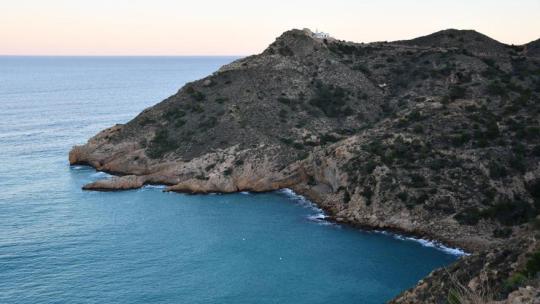
Coast of L'Albir, where the mines d'Ocre cave is located. Alacant, Valencian Country.
I used to hear a story like this when I was a child, too. I don't remember it exactly, but it was about a man who entered a cave where the encantada and the treasure were only visible in full moon nights. The encantada told him how to break the spell and leave with the treasure, but he got too greedy and didn't make it out of the cave before the moonlight rays stopped reaching the cave, so he lost it all and got trapped, if I remember right.
Once again, there are many legends of haunted places like these. And many people have firmly believed that they are real.
I hope this was interesting and answers your question. As always, everyone is welcome to add more to this post if yours is missing.
#catalunya nord#canigó#perellós#òpol#fort libèria#vilafranca de conflent#torrefocs#fort dels banys#els banys d'arles#història
116 notes
·
View notes
Quote
- Mes, que diràn a Barcelona ? Ara bé. Sem a Barcelona o a Russilló ? El Barcelonès diu : jo parlo ; el Valencia diu : yo parle ; el Mallorqui diu : jo parl : el Russillonès diu : jo parli. Qui te ra-hó ? Jo pensi que tots quatre ne tenen, y que cum n'es d'aixo n'es d'allo. - Y donchs, també cairà escriure Canigu al lloc de Canigó ? Perqué no ? Canigu, qui vol dir : Montanya blanca, [...] y perqué convé an als fills del Monseny de pronunciar Canigó, ai xo vol pas dir que nosaltres, qui sem nascuts y qui vivim en Ia falda o al peu d'aqueixa montanya, siguem obligats de fer com ells. Qui sab millor que'ls fills mateixos del Canigú'l nom del gegant llur pare ?
Estève Caseponse (1850-1932) in the introduction of Contes Vallespirechs (1931) about why he doesn’t write “on the manner of Perpinyá” or “following the rules of Barcelona” when writing his Tales of the Vallespir.
“- But what will be said in Barcelona?
Now, are we in Barcelona or in the Rousillon? A Barcelonese says: jo parlo; a Valencian says: yo parle; a Mallorcan says: jo parl, and a man of the Rousillon says: jo parli. Who is right? I think the four of them are and that here and there things are different.
- So, do we also have to write Canigu instand of Canigó?
Why not? Canigu means: White mountain and just because pronouncing Canigó suits the children of Monseny (mountain near Barcelona), that doesn’t mean that us, who were born and who live in its slope or at its foot have to do the same. Who knows better than the children of the Canigu themselves what is the name of the giant they call Father?”
#llengua catalana#renaixença catalana#esteve caseponse#descriptivism#prescriptivism#regional llenguages#catalunya nord#rousillon#linguistics
3 notes
·
View notes
Note
3, 4, 5!
3. What were your top five books of the year?
Already answered!
4. Did you discover any new authors that you love this year?
Already answered!
5. What genre did you read the most of?
Historical fiction I guess??? Not sure what genre some of these books fall under but between the seven Hornblower books and the bit of Patrick O'Brian and El Federal and Canigó (which, you know, technically is historical fiction....) I think that it's not likely to be something else.
Thank you for the ask!
#boat book was definitely the top genre of thing i was thinking about in my Book Thoughts Wrapped so there's that#i don't think jane austen counts as historical fiction but if she and patrick o'brian are a boxed set so#ask games
1 note
·
View note
Text
Ara és estiu cada desembre
Acaricio un camp de blat I un clatell mentre fem mandres Té els llavis de caramel Visc amb el sucre pels aires Mai he vist nas tan bufó Rep petons quan no s’ho espera Baixo cap al Canigó Quan esclata la primavera del meu cor Si soc al millor lloc del món Regal dels déus, carta d’amor Un cor preciós per fer petons A les mans hi té un tresor Les moixaines que em fan perdre El sentit, la…
View On WordPress
0 notes
Photo
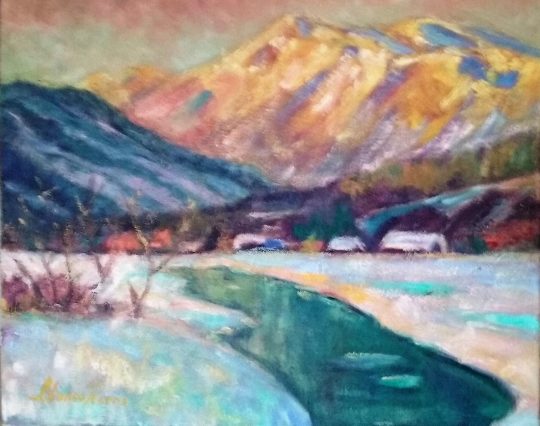
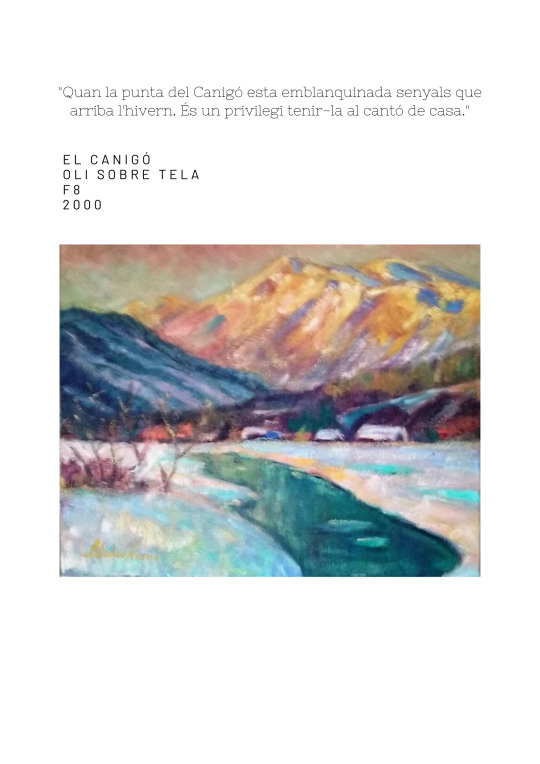
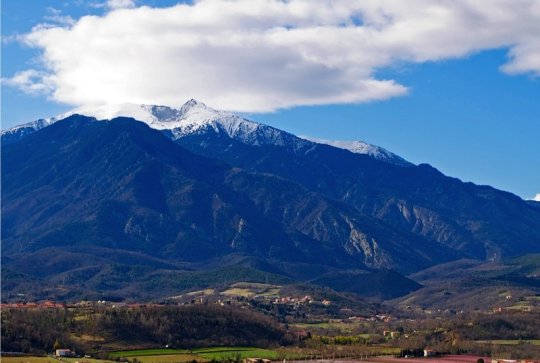
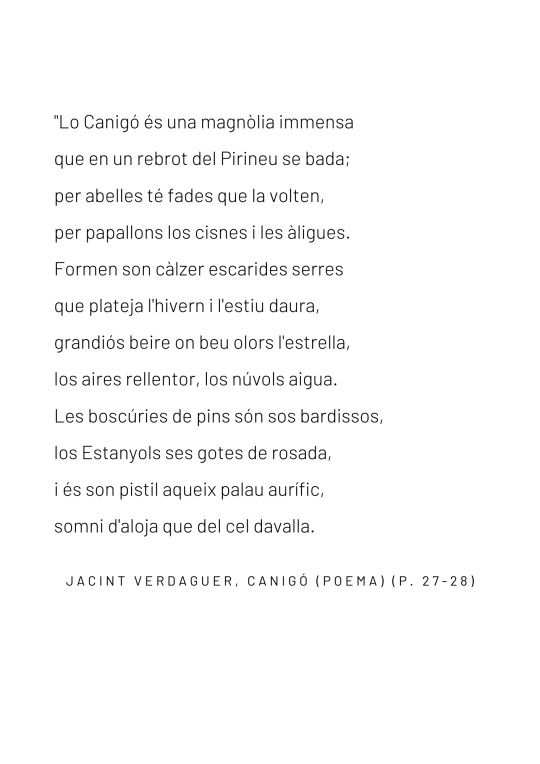
El Canigó és una munanya dels Pirineus situada entre les comarques nord-catalane. Al llarg dels anys esdevingut un símbol de la personalitat de les nostres terres. Tinc la sort de viure a prop d’aquest petit indret, igual que l’àvia. És per això que avui us comparteixo una obra dedicada a aquest paratge natural, acompanyada d’una imatge i d’un dels versos més famosos de Canigó de Jacint Verdaguer, un poema clàssic de la Renaixença.
7 notes
·
View notes
Text
SIENTE EL BIENESTAR DE LA COSTA BRAVA Y EL PIRINEO DE GIRONA. MIMA LA SALUD, TU BIEN MÁS PRECIADO.
Texto: Roser Pruneda · Fotos: Archivo de imágenes PTCBG.
El respirar el aire puro de los Pirineos, el sentir la brisa del Mediterráneo en tu rostro o escuchar el susurro de los árboles. El estar rodeado de esta naturaleza impresionante, donde el cuerpo y la mente encuentran la armonía, y disfrutar de todas las comodidades que ofrece los impresionantes hoteles, spas, balnearios y centros de bienestar de la Costa Brava y el Pirineo de Girona, está al alcance de tu mano.
Escapa de la ajetreada vida de la ciudad y encuentra la paz gracias al Club de Salud y Bienestar del Patronato de Turismo de Costa Brava, Girona. Revitaliza tu cuerpo con las aguas termales de Caldes de Malavella en el Balneario Prats, disfruta de las vistas del Mediterráneo en la cala del Portitxol desde el Spa del Hostal Empúries, o de una de las bahías más bellas del mundo, Badia de Roses, desde el Hotel Spa Terraza. Sumérgete en las famosas agua Vichy Catalán, en el Hotel Balneario que las lleva por nombre, diseñado en estilo neomudéjar, y siente como cada una de las células de tu piel cobra una nueva vida gracias a las propiedades curativas de Vichy. Y para los viajeros más inquietos, el Hotel Ciutat de Girona & Apartaments, en el centro de la capital de la Provincia, ofrece numerosas actividades como: sobrevolar en globo la zona volcánica de la Garrotxa, las montañas del Canigó, Montserrat o Pedraforca, o perseguir el litoral de la Costa Brava, además de talleres de ecoturismo botánico, para los más sibaritas.
Para los amantes de lujo y la exclusividad, Costa Brava y Pirineo de Girona, ofrecen una numerosa cantidad de opciones para recargar la energía de tu cuerpo, mente y alma. El Hotel Peralada Wine Spa & Golf es el Resort por excelencia de la zona, el Hotel Resguard dels Vents, una experiencia única que te permite alojarte en una típica masía a 1000 metros de altitud, el Park Hotel San Jorge, con su incomparable paraje, S’Agaró Hotel Spa & Wellness, que respira vegetación mediterránea por todos lados, Sallés Hotel & Spa Cala del Pi y completísimo circuito de aguas con luz natural que incluyen: piscina, cascadas, jets, camas de agua, banco de lumbares, jacuzzi, sauna, hammam, duchas terapéuticas, cueva de hielo y cueva de sal, o el Spa Hotel Santa Marta, cuyas instalaciones se encuentran en el corazón de un paraje dominado por 7 hectáreas de bosque y con la playa casi privada al alcance de la mano.
Además de estas magníficas zonas de hospedaje, Costa Brava y Pirineo de Girona, proponen el bienestar que alcanza los cinco sentidos. Purifica tu cuerpo por dentro con la propuesta del aula de cocina, EspaiCuinarSa, dirigida por chef y experto en nutrición Matthias Hespe. O practica actividades que te ayudan a reencontrar esa calma, armonía y equilibrio que habías perdido en la gran ciudad, como el mindfulness, el yoga o el senderismo terapéutico, dentro de la naturaleza.
Sobran razones para vivir y sentir la experiencia Wellness de la Costa Brava y el Pirineo de Girona, recuperar tu energía y esa paz interior, pero sobre todo mimar la salud, tu bien más preciado.
Si quieres saber más, te invitamos a conocer la página web, wellness.costabrava.org
2 notes
·
View notes
Text
Pirineos Franceses XI
Perpignan y Alrededores
Cerquita de los Pirineos hay varios lugares dignos de ver, para los amantes de la Naturaleza y del Arte Románico, como es mi caso. Pasando por Prades, y metiéndonos hacia la montaña, hacia el Canigó, está la Abadía de St Michel de Cuixá, (https://abbaye-cuxa.com/?lang=es), fundado en el año 878 es uno de los mejores ejemplos de prerrománico y románico del sur de Francia, también tiene algunos arcos mozárabes. Parte del Claustro está en el Museo de Nueva York. (https://arteviajero.com/articulos/abbaye-saint-michel-de-cuxa/)




0 notes
Video
instagram
#Repost @aligadesantjulia • • • • • • Portant la Flama del Canigó per encendre la foguera del barri de Sant Julià. Gràcies a tots els que ens hi vau acompanyar! __________________________ #AligaDeSantJuliaDeVilafrancaDelPenedes #AligaDeCatalunya #AliguesDeCatalunya #Aliga #Aguila #Aguiles #Aligues #BestiariPopular #FiguresZoomorfiques #ImatgeriaFestiva #CulturaPopular #BestiariFestiu #BallDeLAliga (en Vilafranca del Penedès) https://www.instagram.com/p/CgbtuaGFq0H/?igshid=NGJjMDIxMWI=
#repost#aligadesantjuliadevilafrancadelpenedes#aligadecatalunya#aliguesdecatalunya#aliga#aguila#aguiles#aligues#bestiaripopular#figureszoomorfiques#imatgeriafestiva#culturapopular#bestiarifestiu#balldelaliga
1 note
·
View note
Text
La Flama del Canigó
La Flama del Canigó
Falta només (o encara) un mes per a l’inici de la North Cape. El 23 de juliol, a dos quarts de nou del matí, es donarà la sortida des de Rovereto. La feina la tinc gaire bé feta del tot. D’aquí a una setmana justa, també, sortiré a fer la Lleida – Lleó – Lleida de 1.200 km, l’última prova exigent, una mena d’assaig general per a la North Cape. La intenció és completar-la, tot i que si veig que el…

View On WordPress
0 notes
Text
Language Goals 2023
In the spirit of last year’s very reasonable and achievable goals, here are more reasonable and achievable goals for 2023!
Catalan - I’d like to get the C2 this coming year. I’d also like to read more; specifically Ausiàs March and Vicent Andrés Estellés, and possibly El Canigó and/or El comte Arnau. And if I can, I’d like to write one creative piece in Catalan that I can feel proud of!
Welsh - I’d like to listen to more of Pigion, watch more Hansh videos, and also to find more spaces to use the language in. I really want Welsh to start feeling like a language that I can do things in, because I’m at a level where I can.
Basque - I want to watch at least one or two things in Basque, and, the same as Welsh, for it to be a language that I can use for things, not just a language I’m learning.
Malayalam - I would like to get to a really basic home heritage speaker level of Malayalam by the end of the year—understanding conversations when I visit family, and being able to answer when spoken to. My goal is to watch one Elikutty video per week, and to try to integrate the language into my thoughts and routine more.
Spanish, Galician, Aragonese, Asturian - I’d like to brush up on Spanish for academic purposes, and also to learn a bit about the grammar of the other three. I’d like to start remembering to actually watch A escampar la boira, and to start listening to more music in Aragonese and Asturian. As for Galician, I’d like to go into breaking down lyrics for the many songs I already listen to in it, and maybe watch more videos in it as well. In general, I’m aiming to go into the sphere of Iberian studies, especially Iberian minoritized languages, and so I want to be more familiar with the larger panorama.
Irish, Scottish Gaelic, Cornish, Manx, Breton - Same as for the others above, I want to have somewhat of a functional understanding of more Celtic languages so that I can interact with speakers and media production without needing a translation. I also just listen to a lot of music in at least Irish, and it drives me crazy not to be able to at least superficially understand it. I think the Celtic cultural sphere is really interesting, and so I’d like to be able to learn more about it and talk to more people within it without needing to make them translate to English.
Russian - I really want to be able to understand what people are saying at my friend’s house, and I think that if I put in enough Russian listening practice and vocabulary study I’d be able to piece it together, at least partially; I can already figure it out sometimes with just a few words and context. So I’d like to actually put in some time on that, in the hopes that maybe afterwards, if I spend a few days at her house, I’ll come out understanding Russian sdfhksdhf
Amharic - I’d like to be able to speak some basic Amharic, so my goal is to learn a few basic sentence patterns and some vocabulary, and maybe be able to say one or two things by the end of the year. Nothing big, but just a bit.
I have no idea if I’ll even get close with any of these languages to the goals that I’ve set out here, but I think that if I do, it’ll pay off! And if I don’t, then at minimum, my goal is to learn one thing for each that I can feel good about in a year’s time, and I hope that at least I can do that.
#i really do learn a lot by passive input and it keeps me engaged with the language so i want to increase that rather than my studying time#i do think i'm going to try out anki but we'll see how that goes (?)#this is ambitious i don't think i'll manage it tbh#general:goals#catalan:goals#welsh:goals#basque:goals#malayalam:goals#russian:goals#amharic:goals#spanish:goals
26 notes
·
View notes
Text



Did you know that a Japanese samurai is buried in a village in Northern Catalonia? 🏯 Here's how he ended up in the other side of the world.
Nomura Kosaburo was born in a samurai family in 19th-century Okayama (Japan). His father was a retainer of the Bizen province, serving Lord Ikeda's family. When he was 12 years old, his father died and he inherited his stipends, becoming a samurai himself.
In 1869, he started attending the Army Officers' School “heigaku-ryō” in Osaka (Japan). The school selected 10 of its students to go study in different schools in France. The young Kosaburo was one of the chosen ones, and was sent to the Lycée Louis le Grand in Paris (France). He studied mathematics and received excellent grades, and was scheduled to join a staff officer school, but his plans were cut short when he contracted Tuberculosis.
In 1878, he was advised to go to Southern France, because its dry air was recommended for the treatment of illnesses such as Tuberculosis. He chose the village of Els Banys i Palaldà (Northern Catalonia), a spa town known for its termal water since Ancient Roman times and which had recently built a new military hospital.
Nomura did not survive the illness, he died in 1876. He was buried in the local cemetery, in the tomb you can see in the photos above. The Japanese text means "Tomb of Nomura Kosaburo, Japanese Military Cadet". Below, a text in French says "Here lies Kosaburo Nomura, Japanese military student. Died in Amélie-les-Bains on June 26th 1876 at the age of 21. Perpetual concession." (Amélie-les-Bains is the French name for the village).
His tomb was almost forgotten for 130 years, but now the association Les Amis de Kosaburo - Kosaburo no tomodachi ("Friends of Kosaburo") study his history and preserve his memory in Els Banys i Palaldà and Okayama.
Photos from Vallespir Canigó. Information from Els Banys i Paladà City Council (Mairie Amélie-les-Bains-Palalda-Montalba) and Association Les Amis de Kosaburo.
#història#els banys i palaldà#catalunya nord#japan#japó#other countries#samurai#japanese history#19th century#history#european history#france#french history#travel#europe#asia#okayama#pays catalan#historical
65 notes
·
View notes
Photo




Catala-ning | 4 Catalonian Songs
So, my final paper thematic will be on Catalan and i’m happy if a bit nervous. To celebrate, have a humble edit on my top 4 most beloved traditional songs in Catalan.
Muntanyes del Canigó ○ El testament d’Amelia ○ La meua xiqueta ○ Rossinyol que vas a França
#llengua catalana#catalan#catalonian music#edits#catala#catala-ning will be my thesis tag#catala-ning
57 notes
·
View notes
Text
I’m thinking of starting even more inadvisable writing projects! Like uhhh possibly something that I was thinking of doing a while back with how Stephen ends up in the situation at the start of HMS Surprise (or perhaps not, perhaps just another random situation) but that most certainly involves some good 18th century Catalan and more knowledge of 18th century Lleida than I currently have
#els del llull em donen el certificat i de seguida em converteixo en icarus#no saben el que han creat#be pero si algu te opinions sobre lleida el lleidata el segle xviii/principis del segle xix a catalunya etc etc que m'ho digui#vull un lexic i una gramatica del lleidata del segle xviii perque no puc trobar un lexic i una gramatica del lleidata del segle xviii#tambe he decidit que ja tocava llegir mes coses de la renaixenca aixi que em poso a llegir el canigó i potser més coses després#envieu-me recomanacions necessito recomanacions#okay and yeah well this post goes out to two entirely separate audiences but yeah such is this blog i suppose#anyways the other Creative Endeavour goes interestingly we'll see how it comes out#almost done with ch 3 though! so that's exciting#trying not to think about how much editing it's going to need and trying not to think about all my shortcomings as a writer#i am doing this for myself and for no one else i repeat over and over into the mirror every morning#and then i think about all the ways i am falling short :')#but hey ho we'll get there eventually#i do want to write something in catalan though i think it could be very fun#plus i saw alcarras on friday and. thinking my little evil thoughts#anyways fins aqui no us vull avorrir#send me thoughts and resources thanks <333#The Creative Endeavor and other aubreyad nonsense#perce rambles
4 notes
·
View notes
Photo

El Pedraforca, amb el Canigó al fons; Principat de Catalunya.
#Pedraforca#Canigó#Catalunya#Principat de Catalunya#muntanyes#paisatge muntanyenc#muntanyós#nevat#nivós#hivern#hivernal#paisatge hivernal#paisatge nevat
1 note
·
View note